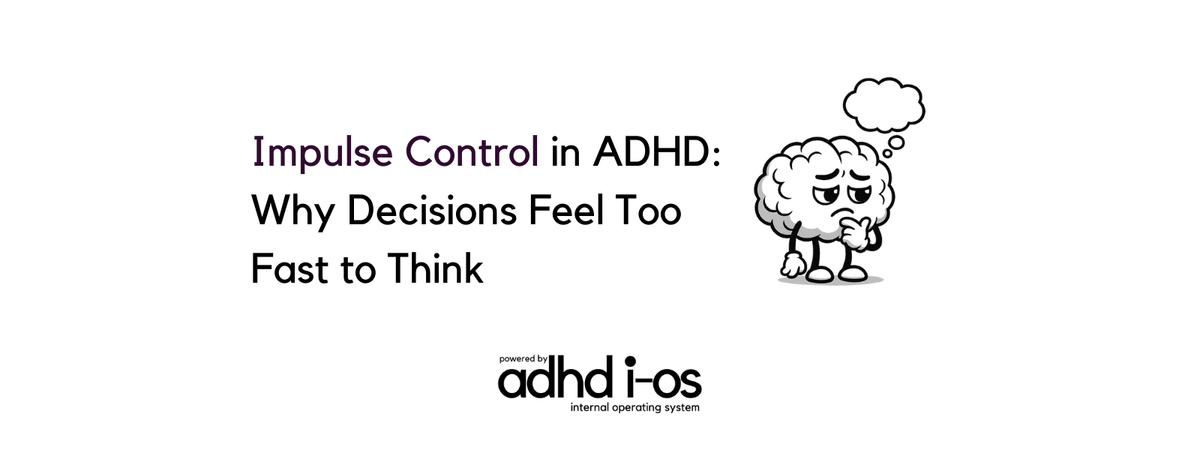Impulse Control in ADHD: Why Decisions Feel Too Fast to Think
Impulse Control in ADHD: Why Decisions Feel Too Fast to Think
Impulse Control in ADHD: Why Decisions Feel Too Fast to Think
Ever said something then immediately regretted it? Or clicked “buy now” before thinking twice?
That’s impulse control – or the lack of it. And for ADHD brains, those impulsive moments often zip by before the brakes even have a chance to kick in.
In this article, we’ll break down what’s actually happening in the ADHD brain when impulse control fails, how neuroscience helps explain that split-second decision-making, and what tools you can try today to build more pause into your process without blaming your willpower.

What Is Impulse Control?
Impulse control is your brain’s ability to pause, evaluate, and choose and not just react.
It’s what keeps you from interrupting in meetings, making a random Amazon purchase at midnight, or opening 12 browser tabs mid-task. But if you live with ADHD, you probably know how fragile that pause can feel.
The Brain Behind the Pause: Neuroscience 101
This isn’t about trying harder. It’s about how your brain is wired.
Impulse control is a neurological function and not a character flaw. ADHD brains process information quickly, but they often skip the internal checkpoints that help others pause.
Prefrontal Cortex: Your Brain’s “Brake Pedal”
The prefrontal cortex (PFC) helps you stop and think before you act. In ADHD, this region (especially the ventrolateral and medial PFC) is often underactive. Translation: the brake pedal doesn’t always engage in time.
Fronto-Striatal Circuits: Your Inner Decision Highway
These neural circuits help the brain talk to itself, linking decision-making with movement and reward. In ADHD, these communication lines are weaker or delayed, making “pause-and-choose” harder to execute.
Dopamine & Norepinephrine: The Chemistry of Control
ADHD brains often have less available dopamine and dysregulated norepinephrine, two neurotransmitters crucial for self-monitoring and delayed gratification. This brain chemistry primes impulsive action over thoughtful restraint.
How Impulsivity Shows Up in Real Life
For some, impulsivity feels creative. For others, it’s a source of daily friction. It’s also one of the most commonly reported challenges by adults with ADHD—even more than inattention in some cases. This shows up as:
- Impulse buys (then regret)
- Interrupting conversations mid-thought
- Opening new tabs instead of finishing one task
ADHD brains can take 20 to 30 milliseconds longer to hit the brakes. That might not sound like much, but it’s the sliver of time where regret often lives.
Why It Feels Impossible: The “Fast Brain” Problem
ADHD isn’t a lack of focus. It’s interest-based focus. ADHD brains are wired to prioritize now over later, because the pathways that support delayed gratification are often underfueled.
In short: your brain wants a reward now. The long-term consequence? That’s Future You’s problem. Read more about why the ADHD brain chooses some tasks over others in Reward Systems: Why ADHD Brains Chase Novelty.
Brain-Friendly Strategies That Actually Help
You won’t stop impulsivity with shame or “just trying harder.” But you can design smarter systems. Here are five tools that work with ADHD brains, not against them:
Strategy - Pause Ritual
How It Helps - Count to 5 or write down the urge before acting. Creates a circuit breaker.
Strategy - Built-In Friction
How It Helps - Use two-step logins or confirmations for purchases or messages. Adds a moment to reflect.
Strategy - Delay Cues
How It Helps - Set a 10-minute timer before deciding. This is especially useful for emotional decisions.
Strategy - External Prompts
How It Helps - Sticky notes or phone alarms to “Pause first.” Gentle nudges can shift habits.
Strategy - Micro-Rewards
How It Helps - Celebrate after you pause and follow through. Dopamine loves a win.
Strategy - Rev Up First
How It Helps - Quick exercise before high-stakes decisions can boost prefrontal activation.
Visualizing the ADHD Impulse Loop
Imagine your brain has two big buttons: one says “NOW!” and the other says “PAUSE.” In many ADHD brains, the “NOW!” button is always easier to press. That’s because the systems responsible for slowing down (like the prefrontal cortex) don’t always activate quickly enough to interrupt the moment.
One way to picture this is like a traffic light: green is the impulse (“go for it!”), yellow is the cue to check in (“wait… should I?”), and red is the pause that lets you consider your options before acting.
By adding intentional cues like visual reminders or structured pause rituals, you can strengthen your “yellow light” moments and build a better bridge between impulse and decision.
Another helpful visual? A simple flowchart:
Impulse → Pause Tool → Decision.
This loop, when practiced, can help ADHD brains regain control without relying on brute-force willpower.
Final Takeaway: Fast Doesn’t Mean Broken
Impulsivity doesn’t mean you’re reckless or lazy. It means your brain processes decisions faster than the brake system can react.
But once you understand the pattern, you can build in buffers.
Try this:
Pick one pause strategy this week. Try it in a low-stakes moment. Then notice what changes physically, emotionally, and mentally.
And if it helps? Share your experience with the adhd i-os community. You never know who else needed that same circuit breaker.

